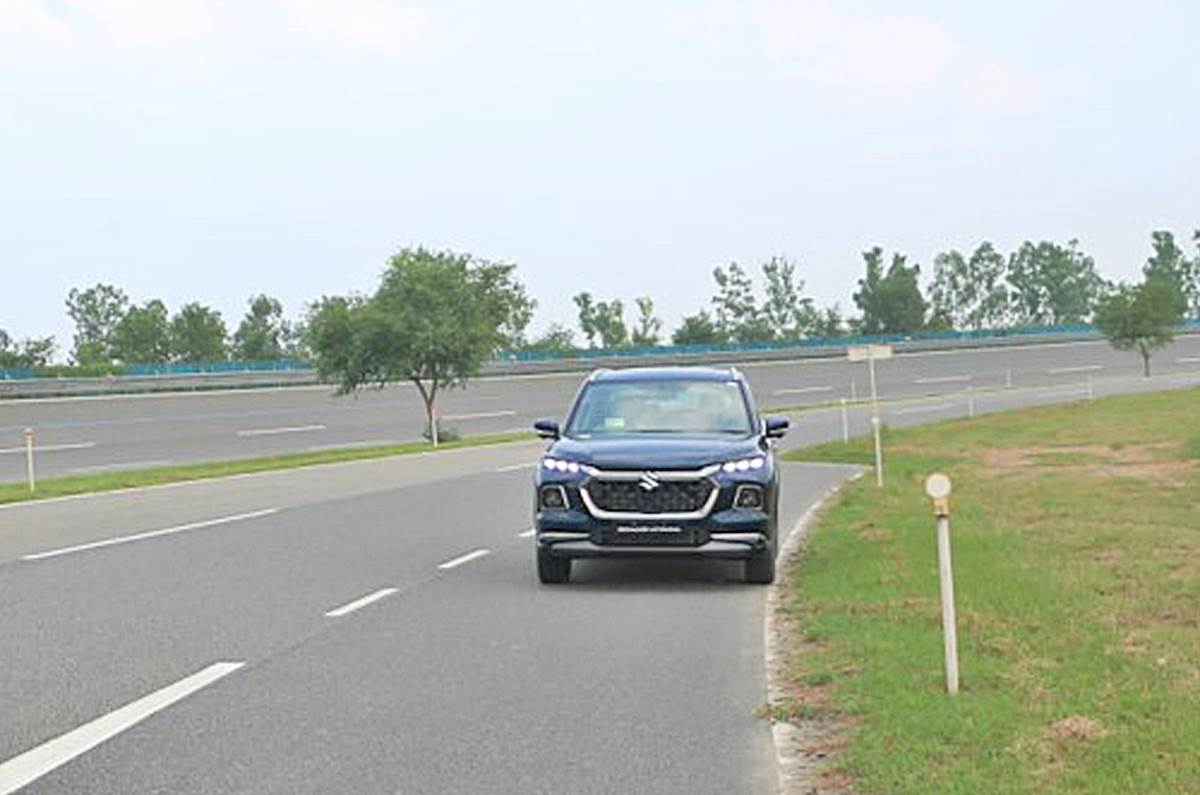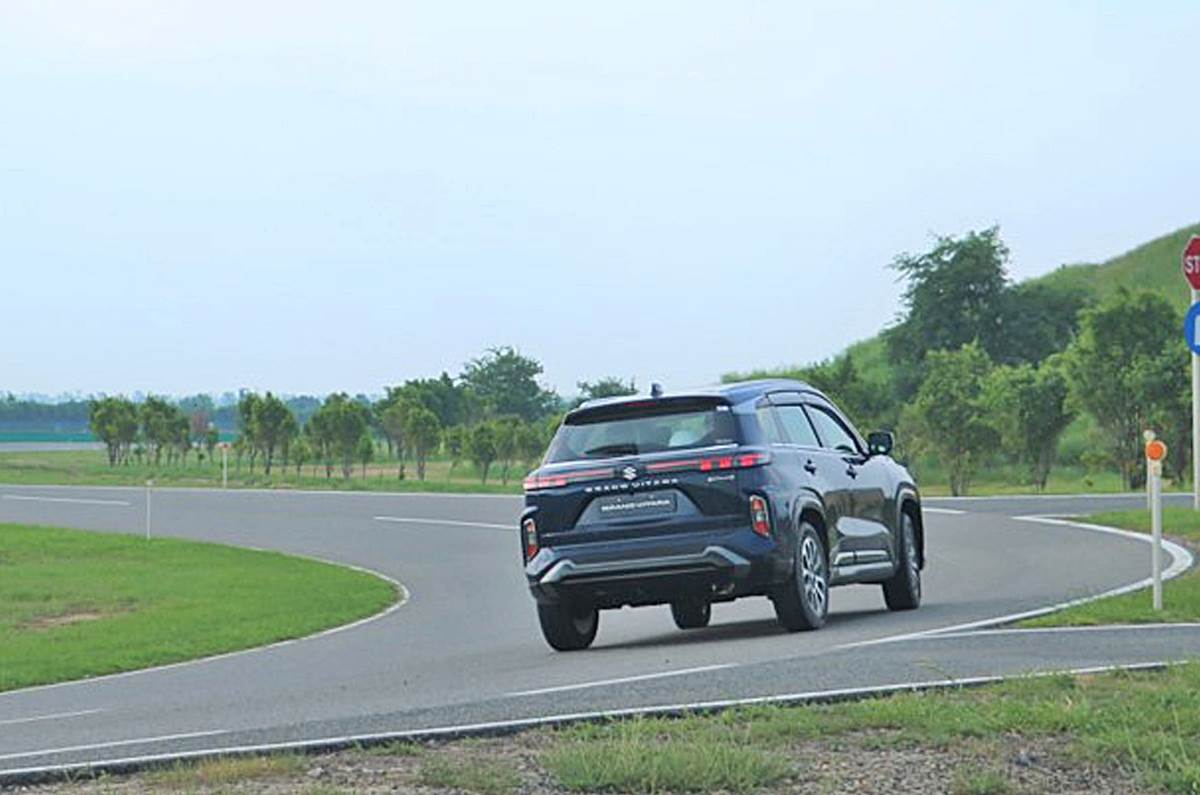After the S-Cross, Maruti Suzuki takes another serious stab at the midsize SUV market; we get an early first preview.
Playing second fiddle isn’t something Maruti Suzuki likes to do, and, to address the S-Cross’ lacklustre performance in the midsize SUV segment, it is readying the Grand Vitara. Besides being the company’s latest stab at the thriving segment, the Grand Vitara also brings in strong-hybrid technology as well as all-wheel-drive – both unique in this segment.
So, while on a media tour of its R&D facilities, when Maruti Suzuki asked if we’d like a short drive, we naturally said yes. And while it certainly was a very short drive – with just a single loop of the banked track, highway loop and city simulation – we did gather some interesting first impressions.
Maruti Suzuki Grand Vitara: engine and performance – Strong Hybrid
Of the three powertrains we sampled, the strong-hybrid was the one I was most curious about given that it’s a Toyota system integrated into the Suzuki Global-C platform that underpins the Grand Vitara. The three cylinder 1.5-litre Atkinson Cycle engine develops 92hp and 122Nm of torque and is paired to an electric motor that makes 79hp and 141Nm of torque. Combined power output stands at 115hp. Modest numbers especially when held against the Creta 1.4 Turbo’s 140hp or the Skoda Kushaq’s 1.5 litre TSI that makes 150hp. And as you’d expect it isn’t quick.
Off the line, it moves quickly, but pace drops off as you build speed. Being the R&D facility, our phones were taken away and the only timing equipment with me was my wristwatch. Going by that the Grand Vitara’s 0-100kph acceleration time was around 14 seconds, and I don’t expect it to dip much more when strapped to our V-Box data acquisition system.

In-gear acceleration is also slow despite the kickdown; it’s clear Maruti is chasing fuel efficiency and the company claims a 27.97kpl figure as per internal testing. And that’s really where this SUV will shine: remember Maruti Suzuki has no diesels and, in this segment, diesels are still popular. Thus, a fuel-sipping petrol should be much appreciated.
The strong-hybrid also has a dedicated EV mode which you can access via a button on the center console. If the battery has sufficient charge and your driving style relaxed, it will motor along happily with the engine shut. Maruti hasn’t disclosed an electric-only range, but says that under typical Indian driving cycle the engine would only be running for 50-60 percent of the time, which is impressive.
I tried EV mode, and, starting from a standstill, the acceleration is nice and smooth and I was able to keep it going with a pace comfy enough for a city drive. However, put your foot down a bit more – like to overtake for instance – and the engine does switch on.
There is no one-pedal driving mode as you find on some EVs, but you have a ‘B’ mode on the gearlever – this is in addition to the Normal, Eco and Sport engine drive modes – which maximises engine braking to charge the battery quicker. While driving in the regular D mode, the coast down feels like a normal ICE vehicle, while in B mode, it feels like a slightly strong regen mode in an EV with the car slowing quite rapidly, although not to a full stop.
Maruti Suzuki Grand Vitara: engine and performance – Mild Hybrid
We also drove the mild-hybrid which uses Maruti’s four cylinder 1.5-litre K15C engine and, like the Brezza, it makes an identical 103hp and 137Nm of torque. Here too, as you’d expect, it isn’t quick with an eye clearly focused on efficiency – Maruti claims 20.58kpl for the auto and 19.38 for the AWD.
As long as you drive in a sedate and relaxed manner you won’t be disappointed and the Suzuki power unit does feel smoother of the two with a lower sound level too. In the Toyota system, during transient phases like acceleration and deceleration you can hear quite a gruff note.

Interestingly, in-gear acceleration in the 20 to 80kph phase felt quicker, though we’ll wait until we can strap it up to our test equipment to finally say so. What was clear, however, was the new 6-speed torque convertor gearbox, which, like on the Brezza, is smooth. What I particularly liked was that with the paddle shifters you can take control of gearshifts and to a large extent the car lets you do as you please – not second guessing you like some other autoboxes do – it will only double beep and not allow a gearshift or automatically shift, incase vehicle and engine speeds are really far out of sync.
We also did get to drive the AWD version, which comes with only the 5-speed manual, not on any off-road or rough terrain. So, what I can say for now is that the manual gearbox shifts feel a bit rubber like, but they are smooth and require little effort.
Maruti Suzuki Grand Vitara: ride and handling
There really isn’t much to say at this point given the extremely brief drive and the specific tracks we drove on, but over the cobble stone section ride quality was nice and pliant. Over speed breakers the body does heave, but it didn’t feel uncomfortable.
What really stood out for me was the steering, the effort was low and at high speeds it felt secure, plus, much to my delight, at parking speeds it automatically self-centers. This is unlike most Maruti’s that simply stay stuck and require you to twirl the wheel back. Thus, with the Grand Vitara, around a corner, you can drive naturally and simply relax your grip on the wheel to have it move back to center.

Maruti Suzuki Grand Vitara: initial drive impressions
Maruti is clearly not taking chances with the Grand Vitara. While it misses out on a diesel, it offers mild-hybrid tech that Maruti is known for as well as segment unique AWD and strong-hybrid technology, which should really be a big draw for many, especially the latter. So, while it will not satisfy those looking for a peppy SUV, for those with an eye on efficiency it should do very well indeed. We’ll of course know for sure once we drive it out in the real world which should be in about a month or two. So stay tuned and incase you’d like to know more about the styling and interiors, do check out our story here.
Also See:
Source link


